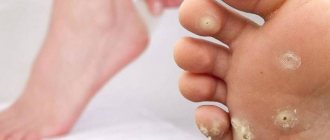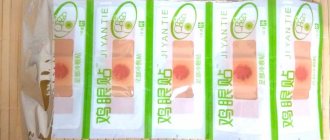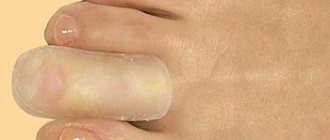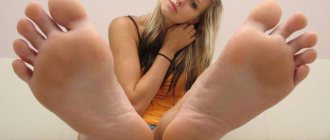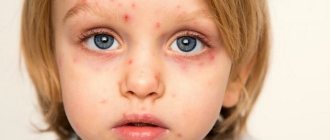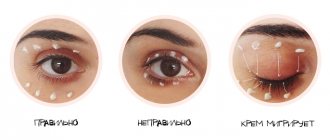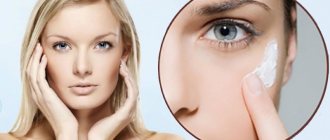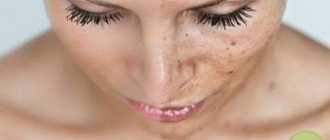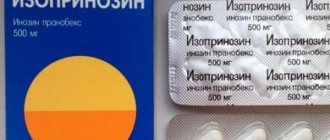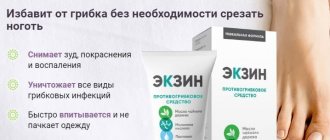.
The skin performs a protective function. Under the influence of negative factors (pressure, sliding and friction), cells die and calluses form on the tissues. The most common occurrence is a heel callus. This is explained by the fact that the heel bears the greatest load. Many people ignore this problem and do not take any measures to eliminate it. But skin lumps are not as harmless as they might seem at first glance. They cannot be ignored.
Callus on the heel requires timely treatment
The problem is not only that the callus hurts, but also that it can cause infection and lead to a number of serious complications. Hardened skin causes a lot of problems and suffering to a person. The appearance of a compaction deforms the foot, and it becomes painful for a person to step on the foot. Over time, a person's gait changes. Therefore, everyone who has encountered this problem wonders how to get rid of it. But to do this, you need to figure out why the corn appeared and find out how to quickly cure a callus on the heel.
Causes of corns
The main cause of this problem is hyperkeratosis or thickening of the stratum corneum of the skin. Hardening of the skin can occur in any person, but most often it affects the older generation. Poor quality shoes, high heels or shoes of the wrong size contribute to hardening of the skin. Poor foot hygiene and synthetic socks also adversely affect foot health. Excess body weight, vitamin A deficiency, fungal diseases, eczema, dermatitis, excessive sweating and many other health problems can trigger the formation of calluses.
Bad shoes are the main cause of blisters.
Types of corns on the heels
Heel calluses can be of three types:
- Dry. A round or oval compaction that appears as a result of keratinization of the skin from constant friction. It practically does not hurt and does not cause discomfort to its owner. Over time, the lump becomes very hard and can become painful. The gait may change and lameness may appear. Dry and hard calluses may indicate health problems.
- Wet. It looks like a bubble filled with liquid. Sometimes it appears in the form of a lump. It is characterized by severe pain. Appears almost immediately after putting on uncomfortable shoes that have rubbed your delicate skin.
- Core or internal callus on the heel. An old corn, the core of which grows into the deep layers of tissue and puts pressure on the nerve endings. This form is the most difficult. It develops in the internal tissues of the heel. A person develops chronic severe pain, and he is practically unable to walk.
A wet callus is extremely painful
Symptoms of an infected callus
- Swelling and redness of the wound and surrounding area. Moreover, the area hurts even with normal touch; wearing even soft shoes with closed heels brings discomfort and severe pain and the inability to move normally.
- Purulent discharge is yellow-brown in color, sometimes mixed with blood. The consistency of the discharge ranges from extremely liquid, similar to water, to thick and stretchy. Sometimes the pus dries, forming a yellow crust on the surface of the wound, under which an accumulation of fluid can be felt.
- The body temperature around the callus increases significantly, it seems that the area of the skin is on fire. If the infection is severe and begins to spread throughout the body, a general increase in temperature is observed as a response of the body.
Infection is extremely dangerous for people with weakened immune systems, the latter category includes:
- patients with cancer;
- people with severe immunodeficiency;
- those suffering from diabetes;
- detecting chronic diseases, especially in severe form;
- people with hormonal imbalances, often observed in those suffering from diseases of the thyroid gland, adrenal glands, and in pregnant women. It is possible in women aged 45-55 years, when menopause begins, in adolescents in adolescence;
- people with difficulties in digestion, in particular with the intestines. At risk is a person who, for various reasons, does not defecate in a timely manner. Constipation leads to the accumulation of feces in the intestines and intoxication of the body. Against the background of the phenomenon, the intestinal microflora, the basis of human immunity, is disrupted. This happens due to recent illnesses that were treated with antibiotics. While taking medications and for some time after the course, it is important to drink a complex of probiotics that help improve the condition of the intestines.
We suggest you read: Is it possible to swim with varicose veins and do water aerobics in the pool? Varicose veins and water aerobics classes.
Don’t think that calluses are not a serious ailment. Indeed, if the formation is not infected and is treated in a timely manner with the necessary means, healing will occur in a couple of days. If ignored, even a small wound can cause significant harm.
Treatment of wet calluses on the heel
The peculiarity of calluses is that they are predisposed to self-healing. The lymph contained in the bladder protects the underlying tissues and prevents from possible further injury. Over time, the liquid resolves on its own, and it is only necessary to provide the necessary conditions for speedy healing. To this end, it is necessary to prevent pressure on the sore area and create comfortable conditions for the feet. The healing period for calluses is fourteen days.
Compared to other types, wet calluses are much easier to treat. It is important to start fighting them in a timely manner, because if you miss time, they will turn into dry ones. There is an opinion that the easiest way to get rid of a wet callus is to pierce it. But under no circumstances should you puncture the blisters, because there is a risk of infection. If infected, the healing process will be long and painful. It is best to seek professional help from a doctor. If this is not possible, then you can try to get rid of the problem yourself.
Before the treatment procedure, feet are washed in warm water, and best of all in cold water to relieve pain. Steaming in hot water can lead to spontaneous opening of the bladder and severe pain.
The feet are then dried and treated with salicylic acid. The treated area is covered with a special anti-callus plaster. You can also make compresses from aloe leaves or lemon zest. The products are applied for two hours and fixed with a bactericidal plaster. You can use special pharmaceutical products that speed up the opening of the bladder.
There are situations when all the measures taken did not give the desired result. In this case, you will need to open the bubble yourself. For the procedure, a thin needle is used, which is pre-treated with an alcohol solution. Feet and hands must be clean. There is no need to treat the bubble with alcohol. The bubble is pierced from the side, and after it is completely cleared of contents, it is treated with hydrogen peroxide. After this, antiseptic ointment is applied and sealed with a special plaster.
A callus that has opened on its own should not be ignored. The burst bubble is washed with soapy water and lubricated with an antiseptic. The dressing should be changed as often as possible.
Before treating calluses, you need to wash your feet
Should I take pain-relieving ointments and creams?
In some cases, the pain is so severe that it deprives a person of the ability to walk. In such cases, it makes sense to use ointments and gels that contain non-steroidal anti-inflammatory drugs. Please note that the use of drugs that relieve callus pain is considered an auxiliary measure and does not replace the main treatment of callus.
If the callus hurts, it is recommended to use Diprospan ointment (Betameson). Used for calluses complicated by bursitis or painful hard calluses. Remember, the ointment is applied only to the affected areas of the skin. The dosage regimen is set individually. The use of such an ointment is an extreme therapeutic measure.
Treatment of dry calluses
It will take a long time to treat dry corns. The therapy consists of completely removing all dead skin cells. The feet are pre-steamed in a soda solution, to which grated laundry soap is added. The steamed skin is treated with pumice and a softening ointment is applied. Wear socks at night. The procedure is repeated until the dry callus on the heel completely disappears. Treatment with emollient creams and ointments can be performed without prior steaming, but in this case, complete recovery will take much longer.
Treatment of calluses with a rod
Core calluses are similar to dry calluses. They can be distinguished by their appearance. They have a clear outline and a well-visualized rod in the center. Calluses can be completely removed only using the hardware method in beauty salons or clinics. The most common method is drilling using a special cutter. After removal in this way, a hole is formed on the skin, into which an antiseptic is poured and sealed with a band-aid.
Recently, laser removal of calluses has become very popular. The procedure is absolutely painless and no painkillers are used.
The recovery process is fast. The laser completely removes the rod. You can also get rid of calluses on your heels using liquid nitrogen. The procedure is called cryoablation. The specialist burns the lump with nitrogen until it can be healed.
Cryodestruction - removal of growth with liquid nitrogen
Removing callus at home
Removal of internal calluses is performed at home. Of course, professional methods will help faster and more efficiently, but when there is no way to turn to professionals, they use their own strength. Remember, you won’t be able to deal with an internal callus on your foot so quickly and easily on your own. The process will require a lot of time, effort and persistence.
It is possible to cut out the callus with a razor, but this method does not guarantee the final elimination of pathologically altered tissue. There is a high risk of injuring surrounding tissues with a sharp blade when performing manipulation; cause infection and provoke suppuration of the process. You will need the help not of a cosmetologist, but of a doctor, and a purulent surgeon.
Treatment with folk remedies
Folk remedies help heal calluses well. Every person who wonders how to get rid of growths will be able to use the available means available at home. There are many different means of solving this problem, which allows each person to choose the best option for themselves. The most common among them are:
- Baths. Use daily until complete recovery. For therapeutic baths, various herbal decoctions (mint, sage, chamomile, birch) are used. You can also make a soda solution to steam the skin of your feet. The feet are steamed in a decoction for half an hour, and then the softened skin is treated with pumice or a special foot brush. After the procedure, the skin should be smeared with a softening cream. In most cases, 2-3 procedures are enough to completely get rid of the problem.
- Compresses. Aloe (or plantain) leaves cut in half are applied to steamed legs. The compress is fixed and left overnight. In the morning, wash your feet in warm water and wipe dry. Honey has also proven to be an effective remedy for treating heel bumps. Honey is applied to the seal, wrapped in film and left overnight. After waking up, the softened skin is treated with pumice. A specific, but very effective way to solve the problem is a garlic compress. Chopped garlic is mixed in equal proportions with butter. The resulting mass is applied to the compacted skin and the compress is secured with a bandage. To obtain quick and effective results, the procedure must be repeated twice a day. It is recommended to combine treatment with garlic compresses with soda baths.
Honey is great for healing chafing
Elimination methods
It is permissible to treat a burst callus using folk remedies. Before any procedure, disinfection is carried out:
- At night, apply lemon peel to the burst callus, wrapping it with a bandage. The procedure is carried out for 3-4 days until the skin on top dries out and begins to peel off.
- It is permissible to make compresses from crushed yarrow. It has disinfecting and healing properties.
- Warm honey will help you cope with the problem faster. It is better to apply not directly to the skin, but to a bandage, which is then wrapped around the callus.
- Apply the serous film of a fresh chicken egg (the membrane containing the egg) to the damaged area. It has a good drying effect.
- Aloe juice is used in many branches of medicine. It is quite possible to treat a burst callus. At night, apply a cut leaf of the plant to the sore spot.
We suggest you familiarize yourself with the signs of toenail fungus (photo)
As you can see, there are a lot of ways to treat burst calluses. It is important to use them correctly and on time. You should not treat calluses as an ordinary ailment that cannot cause harm. She is not as harmless as she seems at first glance.
How to treat? What to do if you have rubbed a callus on your heel? You can get rid of a callus on the heel using conservative or surgical treatment.
How to delete?
As a rule, surgical removal of this formation is extremely rare. They respond well to treatment at home using external cosmetic products.
A doctor is consulted if a painful internal callus occurs.
Important! It is extremely difficult to remove such a formation yourself, and even if this can be done at home, there is a high risk of infection of the wound and the development of an inflammatory process.
How to remove calluses on heels with surgery? The following removal methods are available:
- laser surgery.
Today this is the most modern and effective way to remove calluses with a rod. The procedure is carried out after the introduction of a special anesthetic, so there is no discomfort or pain during it. After removal, the doctor treats the wound and applies a medicinal bandage. With proper care, the wound heals within 2-3 days. - Cryodestruction is the removal of a problem area using liquid nitrogen, which is applied to the surface with an applicator or a special technical device. The session lasts about 1.5-2 minutes. Then the surface is treated with an antiseptic and a therapeutic bandage is applied. Complete healing also occurs within a few days. The method is older, but no less common and effective.
How to quickly heal a callus on the heel? Medicinal preparations for the treatment of calluses include ointments, creams, and tinctures for external use. Many of them are made on the basis of natural plant ingredients, therefore they are safe and have virtually no contraindications.
Hydrogen peroxide is a simple budget remedy that has an antiseptic effect. Quickly softens hardened tissue and prevents the penetration of microbes.
Hydrogen peroxide is added to foot baths, after which the surface is treated with pumice and moisturizer.
- Let's watch a video about using hydrogen peroxide for calluses:
Cream Healer with urea for corns. Contains urea, vitamin E, tea tree essential oil, oak bark extract, celandine. It has a moisturizing and softening effect, relieves fatigue and a feeling of heaviness in the legs, and heals small cracks. Apply to the surface with gentle rubbing movements up to several times a day.
- Compeed patches for wet and broken calluses
, which are glued to the problem area and used until the problem is solved. The patches act quite effectively, soften, eliminate pain, prevent the penetration of microbes, protect against moisture and dirt, and create a protective barrier between the surface of the skin and shoes.
Bielita Pro Pedicure is a product for softening dry calluses and corns. Belita Pro Pedicure contains: glycerin, xanthan gum, as well as citric, lactic and salicylic acids. Apply to clean skin up to several times a day. Can be applied under a gauze bandage.
Before using any pharmaceutical product, be sure to read the instructions for use, contraindications and possible side effects!
How to get rid of calluses using folk remedies? Among traditional medicine, various herbal compresses are widely used:
- from grated raw potatoes and onions;
- from onion skins, raw garlic and apple cider vinegar;
- from fresh lemon zest;
- from garlic and melted lard;
- from baked garlic;
- from pine resin;
- from fresh tomatoes.
The gruel for the compress is wrapped in gauze and applied to the problem area. A tight bandage of sterile bandage is applied on top and left overnight. Often one compress is enough to get rid of the problem.
After removing the bandage, the skin is thoroughly washed under running warm water with baby soap, wiped dry, and treated with an antiseptic. Most compresses are used for wet calluses.
The treatment strategy for water bladder is slightly different.
- The main task with dry calluses is to achieve maximum softening and moisturizing of the skin in order to remove the rough layer.
- When a water bubble forms, there is no need to moisturize the skin. On the contrary, you should open the bubble, treat the wound and dry the problem surface as much as possible.
Yes, this can be done, but only if the bladder is large and tightly filled with subcutaneous fluid. You can make a puncture with a sharp needle, which is held parallel to the surface of the skin.
Before puncturing, the problem area and the needle must be treated with an antiseptic solution. After the puncture, the wound is disinfected and dried.
If a callus has formed on any part of the foot, measures must be taken to remove it. Such a neoplasm is a source of problems: putting on any shoes makes it difficult to walk in them, and sometimes very painful. There are several ways to get rid of the problem:
- removal of growth in the clinic;
- use of medicines;
- use of traditional medicine recipes.
Medical institutions and beauty clinics offer to treat internal calluses using mechanical removal. The traditional methods are:
- Cryodestruction. Low temperatures are used. Liquid nitrogen penetrates the body of the internal callus, destroying its cells and root. There are no noticeable marks left at the site of exposure to cold, but in some cases the risk of re-formation of the growth increases.
- Laser therapy. The procedure for laser removal of internal callus is common and effective; it is used in cases where the formation has reached a large size. Using a laser beam, the root is burned and skin growths are affected. After treatment, the risk of infection, complications and relapses is minimal.
- Drilling. It is a virtually painless method of treatment. The procedure uses a bur and various attachments for it. The growth is drilled out and the rod is removed. Then the doctor treats the wound with medications that affect fungi and bacteria. If the root is not completely removed during the procedure, there is a risk that the callus will reappear in the treated area.
We suggest you read: Rubbed callus hurts, what to do
Pharmacy drugs
For self-treatment of internal calluses at home, medications are used. It is easy to remove a growth on the inside of the foot with the help of accessible, inexpensive drugs that can be purchased at the pharmacy chain. Medicines in this group are presented in a wide range: special liquids, ointments, gels, anti-callus patches.
When you can’t do without the help of a specialist
There are times when pharmacy or folk remedies did not help. Sometimes suppuration and bleeding of calluses occurs. A person wonders what to anoint the problem area with so that the problem disappears. But if such symptoms appear, you should immediately seek professional help from a doctor. Because non-healing wounds on the heels can be a sign of serious diseases (diabetes, herpes and eczema). In this case, in the absence of the necessary treatment, there can be serious consequences, and even amputation of the leg. The specialist will conduct an examination, prescribe tests and, based on the data obtained, select the optimal treatment option and tell you what to do for a speedy recovery.
Prevention of heel calluses
The main preventive measure to prevent corns on the heels is to wear properly sized and comfortable shoes. Interior decoration should be made of natural materials that will not irritate the skin. Summer shoe models must have ventilation so that your feet can “breathe.” Wear socks and stockings made from natural materials that will absorb sweat well. You can use special talc, which absorbs sweat and prevents friction.
It is also necessary to monitor your diet and include in your diet foods containing vitamins A and E. It is important to monitor the condition of your feet, promptly get rid of dead skin cells and treat any wounds using healing agents.
Cover the slightest redness with an adhesive plaster. Regular use of foot baths based on herbal decoctions softens the skin and prevents the appearance of compactions. After water treatments, dry the skin well and apply moisturizer.
Regular foot care and timely treatment will ensure good health and a beautiful appearance. It is worth remembering that if a callus appears on the heel, treatment should be immediate.
